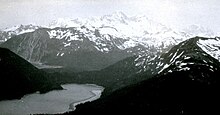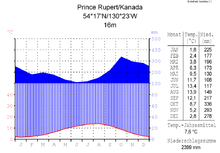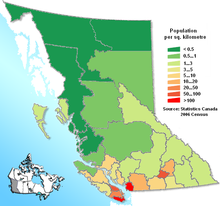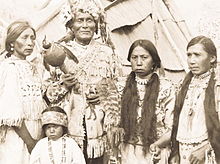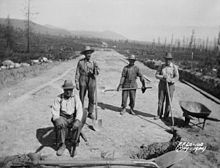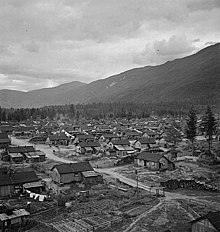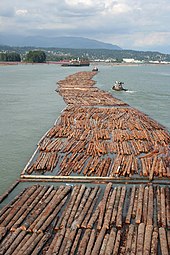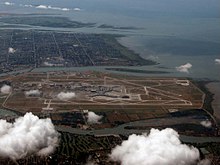British Columbia
| coat of arms | flag |
|---|---|
 ( Details ) |
 ( Details ) |
| Motto : Splendor sine occasu "Splendor without restriction" | |
| location | |
| Basic data | |
| Official language | English |
| Capital | Victoria |
| Biggest town | Vancouver |
| surface | 944,735 km 2 (5.) |
| Population (2016) | 4,648,055 (3.) |
| Population density | 5.0 people / km 2 |
| GDP in CAD (2006) | Total: 179.701 billion (4th) Per capita: 41,689 (7th) |
| Time zone | UTC −7 to −8 |
| ISO 3166-2 | CA-BC |
| Postal abbreviation | BC |
| Website | www.gov.bc.ca |
| politics | |
| Joined Confederation | July 20, 1871 |
| Deputy Governor | Janet Austin |
| prime minister | John Horgan ( NDP ) |
| Sit in the lower house | 42 |
| Seat in the Senate | 6th |
British Columbia [ ˌbɹɪtɪʃ kəˈlʌmbiə ] (also called BC for short ; French Colombie-Britannique , German British Columbia ) is a Canadian province on the coast of the Pacific Ocean . The province's name is derived from the Columbia River . In the northwest, British Columbia is bordered by the US state of Alaska , to the north by the Canadian territories Yukon and the Northwest Territories , to the east by the Province of Alberta and to the south by the US states of Washington , Idaho and Montana . The capital is Victoria .
With an area of 944,735 km 2 , British Columbia is the third largest province after Québec and Ontario . The 2016 census counted 4,648,055 inhabitants, which is 13.22% of the population of Canada and a population density of 5.0 people per km 2 . The majority of the population lives in the southwest of the province. By far the largest city and also the largest economic center is Vancouver . With the exception of the Lower Mainland and the southeastern tip of the offshore island of Vancouver Island , the rest of the province, which is characterized by numerous mountain ranges, is sparsely populated.
The first traces of human settlement go back almost 13,000 years. The First Nations distinguish between numerous groups that can be assigned to the coastal and inland Salish , Kwakwaka'wakw and Nuu-chah-nulth in the south of the province and on Vancouver Island . Further to the north, the Haida live on Haida Gwaii , Tlingit , Tsimshian and Gitxsan on the coast, Tagish , Southern Tutchone and Tahltan in the northern hinterland. The Kutenai , who form their own language group, are added to the southeast . The government differentiates around 200 tribes, including around 130,000 Indians . The vast majority of the population is of European descent, and around half a million Chinese live in the southwest.
Contacts with Europeans at the end of the 18th century led to severe population losses among the indigenous people, mainly due to the smallpox epidemics , to intensive trade in furs and to clashes between Russians, Americans, Spaniards and British. The latter founded the provincial capital Victoria in 1843 as a fort for the Hudson's Bay Company , the predominant trading company in the west from 1821 to 1871. In 1871 the province joined Canada, which had been founded four years earlier. Gold discoveries attracted numerous immigrants between 1858 and 1898. The transcontinental railroad connection, which initiated Vancouver's development into an economic metropolis, provided the connection to the east via the Rocky Mountains . The economic structure of the province was initially strongly oriented towards the exploitation of natural resources, but has diversified over the last few decades.
geography
Expansion and structure
The area of the province is 944,735 km 2 , the length of the coastline around 7,000 km. This is due to the rugged coastline, which is characterized by numerous fjords and offshore islands. By far the largest island is Vancouver Island , which is separated from the mainland by Queen Charlotte Strait , the Strait of Georgia, and the Strait of Juan de Fuca . With a length of over 450 km, a width of around 100 km and an area of 32,134 km 2 , it is the eleventh largest island in Canada. To the north lies the Haida Gwaii Archipelago (formerly Queen Charlotte Islands ) with a total area of 10,180 km 2 . The province has a total of 11,890 islands.
The provincial capital is Victoria on the southeastern tip of Vancouver Island. The most populous city is Vancouver in the southwest of the mainland part of the province, the Lower Mainland . The 49th parallel has been the southern border with the USA since 1846 , the 60th parallel the border with the Yukon and the Northwest Territories, the continental divide partially the border with Alberta. Although located south of the 49th parallel, the southern tip of Vancouver Island also belongs to British Columbia, but not the Point Roberts Peninsula , which can only be reached from Canadian soil.
Geology and landscape
Various mountain ranges stretch through most of the province and unfolded during the Cretaceous Period . During the Würm Ice Age , all of British Columbia was glaciated with the exception of the Haida Gwaii archipelago and small areas on Vancouver Island. In the eastern half of the province run four parallel mountain ranges of the Rocky Mountains . From east to west these are the Continental Ranges , the Purcell Mountains , the Selkirk Mountains and the Monashee Mountains , which unite in the north to form the Cariboo Mountains . To the west of this are the central highlands and the Coast Mountains on the Pacific coast. In the extreme northwest is the Elias chain with Mount Fairweather , the highest mountain in the province with 4663 m.
British Columbia's longest river is the Fraser River . It forms an important traffic artery and drains a large part of the central and southern part of the province to the Pacific. Other major rivers in the south are the upper reaches of the Columbia River and the Kootenay River . To the north, the Stikine River , Nass River, and Skeena Rivers flow into the Pacific, while the Peace River flows towards the Arctic Ocean .
Long, narrow lakes extend in the valleys of the central highlands. These include Kootenay Lake , Okanagan Lake , Quesnel Lake, and Shuswap Lake . Several high dams, particularly on the Columbia River, created large reservoirs such as Kinbasket Lake . The largest freshwater lake in the province is the artificially dammed Williston Lake on the Peace River. British Columbia has a total of 241,576 lakes, which together cover around 22,500 km 2 ; Of these, however, only 16 are larger than 100 km 2 .
There are around 5250 smaller and larger islands off the coast of the province. The largest and most famous island is Vancouver Island . Other large islands are Graham Island , Moresby Island , Princess Royal Island , Pitt Island and Banks Island .
climate
The north of the mainland part of the province is influenced by the arctic climate and has cold, snowy winters. The largest amount of snow measured in Canada per day fell at 145 cm at Tahtsa Lake on February 11, 1999. Due to the influence of the Kuroshio Current in the Pacific Ocean, however, areas in the south and on Vancouver Island have a warm temperate climate . The west coast is very rainy. In 1967 the Ucluelet Brynnor Mines fell 489.2 mm of rain in a single day, the highest amount ever recorded in Canada.
The inland, which lies in the slipstream of high mountain ranges, can get very hot and dry in summer. In the southern central highlands there are some desert-like areas; there is little precipitation and temperatures rise to over 40 ° C in summer. The Okanagan Valley region is the most important wine-growing region in western Canada; there is only 250 mm of rain per year.
Flora and fauna
Little more than four percent of the area is suitable for agricultural use. These areas are concentrated in the south and along the rivers. Otherwise forests dominated.


However, raw material extraction and logging have almost completely eradicated the primeval forests, apart from a few refuges such as the Pacific Rim National Park or Cathedral Grove as well as stocks in the north of the province. Much of the west coast of Vancouver Island and the coastal region of the mainland to the Alaska Panhandle are covered with temperate rainforest. In the northern hinterland, the plant communities of tree species such as black and white spruce , East American larch and firs dominate , as well as Douglas fir and Sitka spruce .
In the north, especially east of the coastal mountains, and in parts of the Rocky Mountains in the east, the caribou lives only in the subspecies Woodland Caribou (Rangifer tarandus caribou) (another subspecies died out on Haida Gwaii in the 1920s ). The number of animals is estimated at only 16,500. It occurs in large herds in the north, such as the Carcross / Squanga, Ibex and Atlin herd, which live in the border area to the Yukon. Two other types, such as the Mountain Caribou and the Boreal Caribou, occur practically only here, but in very small numbers (2500 and 725 respectively). As across Canada, populations are declining due to industrialization and winter recreational activities, primarily due to the disruption from motorized sleds. The importance of hunting is declining here. There are also moose , as the Moose are called, mountain goat and Dall sheep and bison and elk . The predators include the wolf , the grizzly bear , the puma , called cougar , coyote , Canadian lynx , as well as the black bear and the orca .
Numerous are rodents represent different among them as Squirrels called squirrels, ground squirrels , mice, beavers . The latter was one of the numerous fur suppliers, which mainly include spruce marten , ermine , weasel , mink , otters , but also Canadian lynx and red fox .
British Columbia is home to over 300 species of birds, including around 65 endemic . Among the most culturally significant for the First Nations are the raven , the bald eagle and the golden eagle . The peregrine falcon should be mentioned among falcons . Among the pheasants there are the fir grouse and rock mountain grouse , but also the collar grouse .
The most important fish are the Pacific salmon , the king salmon (chinook), the red salmon ( sockeye), the keta (chum) and the silver salmon (coho). They migrate up the rivers in huge swarms to spawn and in many places form the crucial basis for the ecosystems there.
Cities, places, population distribution
British Columbia has few metropolitan areas. Every second resident of the province lives in the Greater Vancouver metro area , which, in addition to Vancouver itself, is made up of several independent communities. According to the 2006 and 2011 censuses, the largest cities by population were:
|
|
The following map and the results of the 2006 census for the 26 census agglomerations show how unevenly the population is distributed :
|
|
history
Early history
The oldest traces of human presence were estimated to be 12,500 years ago, until a 14,000 year old settlement was found on Triquet Island . They point out that the coast of the province was of great importance for the southern migration of Indian groups, especially since it remained partially free of ice during the last ice age.
Especially on the coast, the supply for the slowly growing communities was secured by the abundance of marine mammals, fish and game, but also of materials such as wood and wood fibers, berries and grass. On this basis, complex, hierarchical social systems with outstanding cultural works developed early on - the totem poles and masks are famous . Large villages, which were permanently inhabited in winter, and plank houses were characteristic, the most important domestic animal was the dog, which served as a guard and whose hair was made into textiles. Specific groups can be recognized early on, to which the Tsimshian, Tlingit, Nuu-chah-nulth, Kwakwaka'wakw and coastal Salish go back on the coast . Whale hunting shaped the Nuu-chah-nulth culture on the west coast of Vancouver Island.
The oldest find from the northwest comes from a cave in the Tongass National Forest (discovered in 1996) on Prince of Wales Island and is dated to an age of 10,300 years. Finds on the lower Fraser River and on Vancouver Island date from the same period.
In the hinterland the cultural area of the plateau extended, which in British Columbia means the Fraser Plateau. Storage houses enabled a noticeable population growth from around 2000 BC. BC, which can be used to connect large villages, some of which have been in continuous use for more than a millennium. Inland Salish groups and Kootenay were dominant here , but came around 500 BC. Chr. Eyak-Athapaskish speakers such as Chilcotin and Dakelh were added. Life in the drier hinterland was only partially based on fishing. Hunting and collecting were more important here.
The north, on the other hand, belongs to the sub-arctic cultural area, which becomes tangible only very late due to its thin population. Here lived Taku River Tlingit, Tagish , Dease River ( Tahltan ) and Southern Tutchone .
European trade
It is believed that Sir Francis Drake may have explored the coast of British Columbia as early as 1579 , but it was not until 1774 that Juan José Pérez Hernández made the first documented journey to look for possible Russian settlements and to take possession of the land for Spain . The expedition of Juan Francisco de la Bodega y Quadra followed a year later . From 1775, perhaps a third of the native population fell victim to a smallpox epidemic introduced by the Spaniards .

In 1778 the Briton James Cook reached the coast in search of the Northwest Passage and came into contact with the Nuu-chah-nulth on the Nootka Sound . As a result, a brisk fur trade with China, organized by the British, developed . Conflicts arose between Great Britain and Spain over influence in the Pacific Northwest , which could be peacefully settled in 1794. George Vancouver was busy surveying the area at the time.
In 1793, Alexander Mackenzie , a member of the North West Company , was the first European to reach the coast from the east. Mackenzie's companion, John Finlay , founded Fort St. John in 1794 , the first permanent European settlement in British Columbia. In 1808, Simon Fraser explored a large part of the interior along the river named after him . In 1811 David Thompson explored the entire length of the Columbia River . These trips were not made for political reasons, but primarily served to find new trade routes.
South of the border with Russian America (54 ° 40 'N), in addition to the North West Company, the Hudson's Bay Company (HBC) and the American Fur Company were also active in the fur trade. Great Britain and the USA signed the London Treaty in 1818 , which provisionally regulated the joint use of the area then known as the Oregon Country . After the merger of HBC and North West Company in 1821, what is now British Columbia was divided into three commercial districts. The northern and central part of the interior formed New Caledonia (administrative seat Fort St. James ). The interior south of the watershed of the Thompson River and north of the Columbia River belonged to the Columbia District with the administrative seat of Fort Vancouver . The extreme northeast, known as the Peace River Block , was part of the Athabasca District administered from Fort Chipewyan , Alberta .
British occupation
Until 1849, these commercial districts were territories in British North America that were de facto under the jurisdiction of the HBC administrators. In contrast to Rupert's land in the north and east, the districts were not leased to the society. The HBC only had a trade monopoly with the indigenous people and was not interested in colonization for the time being. However, that changed in the 1840s when the United States continued to expand its sphere of influence westward. This led to overlapping territorial claims, especially on the lower reaches of the Columbia (in today's states of Washington and Oregon ).
In order to secure the British claims, the Fort Camosun was built on Vancouver Island in 1843 , from which the city of Victoria later developed. In 1846, with the Oregon Compromise , Great Britain and the USA set the 49th parallel as a common border , while the Vancouver Island, which protrudes further south, and the Gulf Islands came completely into British possession. In 1849 the crown colony of Vancouver Island was founded , with Victoria as the capital. New Caledonia, as the entire mainland part of the later province was called, remained a territory under the informal administration of the HBC.
Gold finds and massive immigration
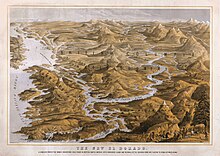
When Governor James Douglas shipped a shipment of ore to San Francisco for inspection in 1858 , it was found that the ore, mined north of Yale on the Thompson River , contained gold . This discovery sparked the Fraser Canyon Gold Rush , and Victoria quickly turned into a large tent city. Thousands of (mostly American) prospectors, speculators, agents and traders moved here. The Fort Langley HBC served many prospectors as a starting point, although Governor Douglas had only access via Victoria allowed. Tensions arose between prospectors and Nlaka'pamux and finally the Fraser Canyon War .
At the beginning of the gold rush, the mainland part was not yet under formal administration by the British state. With thousands of Americans present, Douglas feared losing British influence. A gunboat he had requested forced license fees on the Fraser River for boats and ships that wanted to go on the river. The British Colonial Ministry finally declared the mainland part of the Crown Colony of British Columbia on August 2, 1858 , with New Westminster as its capital. Douglas was appointed governor of both colonies.
As soon as the Fraser Canyon gold rush was over, gold was discovered again further inland. During the Cariboo gold rush in 1861/62, tens of thousands of people poured into the Barkerville and Lillooet area . It was they who brought in diseases unknown to the Indians, to which there was almost no resistance. In 1862 around half of the Indians in the west and northwest died of a devastating smallpox epidemic .
In order to facilitate access for Europeans and to better control the Cariboo area, the government of the colony had the Cariboo Road (also called Cariboo Wagon Road or Great North Road ) built. With the income from license fees, it financed the provision of a basic infrastructure in the rapidly growing gold cities. However, the government ran a large deficit. The two colonies were therefore merged to form the United Colonies of Vancouver Island and British Columbia on August 6, 1866 , with Victoria as the capital.
Connection to Canada
The decline in economic power after the end of the gold rush and the desire for self-government and independent government led to the formation of a political movement that called for the colony to join the Canadian Confederation , which emerged in 1867 from the union of three British colonies in the east of the continent. In particular, the Confederation League, led by the three later Prime Ministers Amor De Cosmos , John Robson and Robert Beaven , represented this concern. The decisive factor, however, was the support from John Sebastian Helmcken . Their main arguments were the fear of a possible annexation by the USA and the large deficit due to the strong population growth - after all, the population was estimated at 60,000 in 1871.
Finally, on July 20, 1871, British Columbia became the sixth province to join the Confederation. In return, the Canadian state undertook to assume the debt and promised to build the Canadian Pacific Railway within ten years. However, the fulfillment of this promise was delayed. It was not until November 7, 1885, when the symbolic “last nail” was set in Craigellachie that the transcontinental railroad was completed.
Aided by the easier accessibility, numerous coal and iron ore mines as well as iron works were built, especially in the southeast of British Columbia . Several new cities were founded in their vicinity. In addition to mining , forestry , agriculture, and fishing also began to play a significant role, and the prospect of job opportunities attracted many immigrants. The economic boom promoted the development of the old fur trading posts (such as Victoria , Nanaimo , Prince George , Kamloops and Fort St. John ) into large cities. However, Vancouver became the largest city in the colony . Vancouver owed its rapid rise above all to the fact that the Canadian Pacific Railway moved its western terminus here in 1887 and that extensive port facilities could be built here, from which the province's mineral resources could be exported.
Industrialization, immigration, political parties
It was not until 1903 that the boundaries of the province were finally established. In 1825, Great Britain and Russia signed an agreement to define the boundaries between their possessions, but the wording was very imprecise. When Alaska was bought by the US in 1867 and British Columbia joined Canada in 1871, Canada requested a survey of the Alaska Panhandle , which the US refused for reasons of cost. In 1903, US Secretary of State John Hay and British Ambassador Michael H. Herbert negotiated a compromise. Since then, the border runs roughly in the middle of the respective mutual territorial claims.
The exploitation of natural resources required a great deal of manpower, which, under the conditions at the time, amounted to a large number of immigrants, because the working reservoir of the Indians and the early settlers was far too small. The immigrants came not only from Europe, but increasingly also from China , British India and Japan , which often led to racist attacks. At the political level, the immigration of non-European people was increasingly restricted. The enactment of the Chinese Immigration Act 1923 made immigration of Chinese practically impossible (only traders and investors were excluded).
In 1914 a second transcontinental railroad line was completed with the Grand Trunk Pacific Railway . It led through the north of the province from Yellowhead Pass via Prince George to Prince Rupert . This route enabled the economic development of the previously sparsely populated region.
In 1917 the alcohol prohibition came into force, but it was lifted again in 1921 because it could not be enforced because of the black market trade and rampant corruption . Since the production and sale of alcohol in the contiguous United States remained banned, developed in British Columbia a thriving alcohol industry that their products through smuggling brought across the border. The global economic crisis plunged the province's economy into a deep recession from 1929 onwards.
With the outbreak of the Second World War , there was strong growth in the arms industry. This, together with increased demand for raw materials, led to a rapid economic upturn. In 1942, a few months after the attack on Pearl Harbor , the Canadian government viewed Japanese-born Canadians as a national security threat, much like the Germans did during World War I. They were expropriated, rounded up and then interned in inland camps. It was not until 1988 that the Canadian government officially apologized and made compensation payments. In the post-war period there was a change in provincial politics. The previously dominant liberals and conservatives suffered a severe defeat in the 1952 elections and sank into insignificance. Under Prime Minister WAC Bennett , the British Columbia Social Credit Party rose to be the strongest party. British Columbia experienced an unprecedented economic boom during Bennett's twenty year reign. Apart from a brief reign of the British Columbia New Democratic Party (NDP) from 1972 to 1975, the Social Credit Party remained in power until 1992. However, due to numerous political scandals during the reign of Bill Vander Zalm , the Social Credit Party collapsed completely. Their electoral base turned almost completely to the resurgent British Columbia Liberal Party , which has been in government since 2001 after an equally scandalous and economic slump ten-year reign of the NDP. The liberal government sought to privatize the crown land and for this purpose initiated the so-called Working Forest Plan , which provides for the economic use of all forest areas on this land. However, it failed for the time being in 2004 due to resistance from numerous residents.
population
| Population development | |||||
|---|---|---|---|---|---|
| year | Residents | year | Residents | ||
| 1851 | 55,000 | 1941 | 817.861 | ||
| 1861 | 51,525 | 1951 | 1,165,210 | ||
| 1871 | 36,247 | 1961 | 1,629,062 | ||
| 1881 | 49,459 | 1971 | 2,184,620 | ||
| 1891 | 98.173 | 1981 | 2,744,467 | ||
| 1901 | 178,657 | 1991 | 3,282,061 | ||
| 1911 | 392,480 | 2001 | 3,907,731 | ||
| 1921 | 524,582 | 2011 | 4,400,057 | ||
| 1931 | 694.263 | ||||
In the 2016 census, 4,648,055 inhabitants were determined, which corresponds to an increase of 5.6% compared to 2011. British Columbia is thus slightly above the national average with an increase of 5.0%. British Columbia accounts for 13.22% of the total population of Canada.
24.3% of the population identified themselves as "Canadians" in the 2001 census. 29.3% were of English , 19.4% Scottish , 14.5% Irish , 12.9% German , 9.7% Chinese , 8.6% French and 4.8% Indian ancestry (multiple answers possible). Around 175,000 people or 4.5% are of indigenous origin ( First Nations ), another 45,000 (1.2%) call themselves Métis .
The main language is English , which is spoken by 71.5% of the population as their mother tongue. 8.5% speak Chinese languages , 4.5% Punjabi , 2.2% German and 1.4% French . 31.4% of the population are Protestant , 17.2% Roman Catholic , 0.9% Christian Orthodox and 5.2% unspecified Christians. 3.5% profess Sikhism , 2.2% Buddhism , 1.5% Islam and 2.0% other religions. 35.9% did not provide any information.
The province is sparsely populated; the population is concentrated in the metropolitan areas in the Fraser River valley around Vancouver and around Victoria on Vancouver Island. British Columbia is very multicultural . In some cities in the Lower Mainland , the Chinese make up the largest population group.
State
Politics and administration

The political system of British Columbia is based on the Westminster system , with a unicameral parliament, the legislative assembly . This consists of 79 members who are elected in just as many constituencies according to the majority voting system. Under a 2001 law, parliamentary elections take place every four years on the second Tuesday in May. Previously, on the advice of the Prime Minister , the lieutenant governor was able to dissolve parliament prematurely within a certain timeframe and call new elections, in line with British parliamentary tradition. In a referendum in 2005, 57.7% of the electorate voted for a change in the electoral system from majority voting to transferable individual voting . However, the formal requirement of 60% approval was not met. Another referendum in May 2009 failed with just under 39% approval.
The last parliamentary election took place on May 9, 2017. The British Columbia Liberal Party (LP) lost it and got 43 seats in the 87 seat parliament. It continues to be the party with the most seats. The British Columbia New Democratic Party (NDP), a social democratic party , gained seats, however, to 41 seats. Together with the Green Party of British Columbia , which got 3 seats, it achieved a majority in parliament. Acting Prime Minister is John Horgan (NDP). The formerly important British Columbia Social Credit Party that ruled the province for four decades is now meaningless. British Columbia currently has 36 seats in the House of Commons and six seats in the Senate under the Canadian Constitution . Like the other provinces of western Canada , British Columbia is severely underrepresented in the Senate.
The monarch's constitutional and ceremonial duties are currently carried out by incumbent Lieutenant Governor Janet Austin .
Ministries and Government Organizations in BC
State administration in BC is carried out by the various ministries and their assigned agencies. Furthermore, there is state action by the various Crown Corporations (" Crown corporations ", a public company ).
Ministries: (The translations in brackets are not official translations!)
- Aboriginal Relations and Reconciliation (Ministry of Aborine Relations and Reconciliation)
- Advanced Education (Ministry of Continuing Education)
- Agriculture (Ministry of Agriculture)
- Children and Family Development (Ministry of Children and Family)
- Community, Sport and Cultural Development (Ministry of Community, Sport and Cultural Development)
- Education (Ministry of Education)
- Energy and Mines (Ministry of Energy and Mines)
- Environment (Ministry of Environment)
- Finance (Ministry of Finance)
- Forests, Lands and Natural Resource Operations (Department of Forest, Land and Natural Resource Management)
- Health (Ministry of Health)
- Jobs, Tourism and Innovation (responsible for Multiculturalism) (Ministry of Labor, Tourism and Innovation)
- Justice (Ministry of Justice)
- Labor, Citizens' Services and Open Government
- Social Development (Ministry of Social Development)
- Transportation and Infrastructure (Ministry of Transportation and Infrastructure)
Agencies:
- BC Public Service Agency
- Board Resourcing and Development Office
- Crown Agencies Resource Office
- Francophone Affairs Program / Program des affaires francophones
- Government Communications and Public Engagement
- Intergovernmental Relations Secretariat
- Office of the Premier
- Public Sector Employers' Council Secretariat
Crown Corporations:
- BC assessment
- BC Housing
- BC Hydro and Power Authority
- BC Rail
- BC transit
- British Columbia Lottery Corporation
- Community Living BC
- Industry Training Authority
- Insurance Corporation of British Columbia (ICBC)
- Legal Services Society
Regional districts
British Columbia is divided into 29 regional districts . As in some counties in the United States, regional districts perform administrative functions in unincorporated areas . In these predominantly rural regions, the regional districts are responsible, among other things, for spatial planning, building inspections and fire protection, and in their entire area (including municipalities) also for waste disposal and disaster control . Regional districts are governed by a council made up of directly and indirectly elected members. Local councils and city councils appoint their representatives on the regional council, while residents of unincorporated areas elect their representatives directly.
Official symbols
Like most countries in the world, British Columbia has its official symbols. In contrast to Germany, where the symbols include the flag and the anthem, most North American states have more symbols. For British Columbia the symbols are:
| symbol | Illustration | Recording as a symbol | annotation | |
|---|---|---|---|---|
| coat of arms | British Columbia Coat of Arms | October 15, 1987 | ||
| flag | British Columbia flag | June 14, 1960 | As a coat of arms banner , the flag represents the figures from the shield of the provincial coat of arms . | |
| motto |
Splendor sine occasu (Splendor without diminishment) |
- | October 15, 1987 | German: splendor without restriction |
| flower |
Pacific dogwood Cornus nuttalli |
1956 | ||
| mammal |
Ghost bear Ursus americanus kermodei |
April 2006 | The ghost bear is better known as the kermode bear . | |
| bird |
Steller's Jay Cyanocitta stelleri |
December 1982 | The Steller's Jay (Diademed Jay ) was elected provincial bird by the population. | |
| tree |
Western Redcedar Thuja plicata donn |
February 1988 | The Western Redcedar (giant tree of life) was chosen as the tree of the province because of its special economic importance. | |
| Gemstone | jade | 1968 | The jade is the province's gem, as it was mined in numerous mines in British Columbia. | |
| Tartan | Blue, white, green, red and gold | - | 1974 | The colors are supposed to represent the blue of the ocean, the white of the provincial flower, the green of the forest, the red of the maple leaves and the gold of the shield and flag. |
economy
The gross domestic product (GDP) in 2002 was 135.6 billion Canadian dollars (CAD). That was around 11.7% of Canada's GDP. Although the share of the raw material processing industry is slowly decreasing, it is still a focus of the export economy. The timber industry alone contributed CAD 10.8 billion, followed by the paper industry (4.8 billion), food (4.3), metal goods (1.6), mechanical engineering (1.6), minerals without metals (1, 4), transportation equipment (1.3) and chemical industry (1.1).
In 2003, 2.04 million people were employed, 163,600 were registered as unemployed. This corresponded to an unemployment rate of 7.4%. A minimum wage of eight CAD applies.
The labor market has been reflecting economic change for years. 332,900 people were employed in commerce alone, 212,600 in health and social services, 202,000 in production, 170,600 in food processing and hotel and restaurant industries, 149,400 in services in the fields of science and technology, 143,100 in education, 132,800 in finance, insurance, real estate and leasing, 121,700 in house construction, 114,600 in transport and storage, 105,600 in information, culture and recreation, 99,700 in public administration, plus 98,100 in other service areas. There were 85,000 employed in management, administration and other support services. Then came the forestry, fishing, mining, oil and gas industries, which together employed only 44,600 people, ranking them ahead of agriculture (32,700) and energy supply (13,500).
Agriculture was based on around 20,000 farms, which, however, only worked 26,000 km 2 of land. Garden and medicinal plants come before food production. Agriculture is particularly beneficial in the Mainland-Southwest Region , in the south of Vancouver Island and in the Thompson-Okanagan region . The latter form an important wine and horticultural area. However, 85% of the grain grows in the region around the Peace River . But rural income is extremely low ($ 10,954 pre-tax, 2000). More successful products are mushrooms (15,000 t / a) - the province is the largest producer in this area in the west of America - and American ginseng , the largest cultivation area of which is here worldwide (590 ha). The fastest growing agricultural sector is organic farming, to which 320 farms were dedicated in 2001.
In 2004 the province had 740,000 cattle, 170,000 pigs and 61,000 sheep. Here sales rose from 2002 to 2004 alone by six percent to 1.19 billion CAD. Milk production was 510 million liters.
Almost as extensive is the fish industry, bringing in nearly a billion CAD. More than 500 fish farms , mainly on Vancouver Island, mainly breed salmon , but are also blamed for severe drops in wild fish populations. It is estimated that there are around 300,000 private anglers , around 16,000 of whom fish commercially and around 6,000 own boats.
453,000 km 2 of land is still covered by forest today. The province exports around 35% of the world's exported softwood. Nonetheless, the industry with its ruthless deforestation technology is meeting with increasing criticism. In addition, more and more raw wood is exported, which threatens the wood processing companies in the province. But that means the support in the population continues to decline. In addition, the deforestation of the last primeval forests is damaging tourism and provoking resistance from the First Nations.
The energy supply is almost exclusively in the hands of BC Hydro , a state-owned company which, according to its own information, supplies 95% of households and mainly relies on hydropower. In recent years, however, wind and solar energy, as well as geothermal energy, have been added.
Overall, the province has a negative trade balance. In 2002, goods worth $ 59.3 billion were exported and imported to the value of $ 67.1 billion. Of the exports, however, 19.5 billion remained in Canada, and 29.3 billion came from the other provinces of Canada. The largest commercial center by far is Vancouver, through which around 50% of exports and imports are handled. The province has the highest tax rate in all of Canada (almost 50%).
With the film industry settled in the greater Vancouver area, British Columbia has developed into the third largest film production location in North America (after Los Angeles and New York). There are three larger film studios in Vancouver alone, in which Canadian and US American cinema and television films, TV series, TV shows and documentaries are produced. Due to the large number of film productions, the term Hollywood North first developed in Vancouver, through further film studios in other provinces, including Ontario , and then across Canada.
environment
British Columbia's environmental policy is subject to strong cyclical fluctuations, as the province is very dependent on world market prices for raw materials. In addition, nature has become the most important factor for tourism . But tourism, nature conservation, recreational and scientific interests are at odds with the exploitation interests of the raw materials industry and occasionally the interests of the indigenous people.
There are only a few primeval forests (old growth) in British Columbia after almost a century of overexploitation . They would have completely disappeared without the resistance of environmental organizations such as the Western Canada Wilderness Committee or the Friends of Clayoquot Sound and the Indians . The companies in the timber industry are so closely linked to the provincial political elite that only international pressure and often coercion from the federal government and the courts of law were able to save the stocks in some cases (see Clayoquot Sound ). At the same time, raw wood exports have destroyed 60 processing companies and 20,000 jobs since 2001.
There are 14 different types of parks and reserves in British Columbia. Seven of Canada's 43 national parks are in British Columbia. These are the Gulf Islands National Park and Gwaii Haanas National Park as well as the Pacific Rim National Park on the west coast, plus Kootenay National Park , Mount Revelstoke National Park , Yoho National Park and Glacier National Park in the Rocky Mountains . In addition, the provincial government maintains almost 1,000 provincial parks and other protected areas. Thus almost 15% of the area of the province (approx. 114,000 km 2 ) is under protection to a certain degree.
The use of hydropower to generate electricity is well developed and is used to a large extent to supply electricity to cities along the Pacific coast as far as Mexico . The reservoirs impede the fish migration that is essential for the regional ecosystem. The Fraser, Nass and Skeena rivers have been partially left to nature to protect the salmon. Salmon farming, however, endangers stocks through displacement and disease.
traffic
Up until the 19th century, waters were the most important traffic routes, alongside which trade routes existed. Only over the canyon of the Peace River and a few other rivers was there a connection eastward over the Rocky Mountains . The province was mainly connected to Europe and Canada's east via Cape Horn , via the USA or via the Asian routes. Steamers served the more important inland routes, with canal construction playing only a minor role here. Public shipping was nationalized in 1960 with the establishment of BC Ferries for around 25 routes between Vancouver Island and the Lower Mainland, thereby replacing routes on the Canadian Pacific Railway. BC Ferries works closely with Washington State Ferries on the routes to Sidney and Anacortes as well as with Black Ball Transport to Port Angeles . Numerous other ferry services are run by the province. The most important ocean ports besides the port of Vancouver are those of Prince Rupert and Victoria.
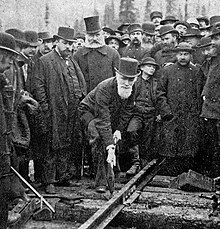
With the completion of the Canadian Pacific Railway in 1885, the railroad became the province's main mode of transport until the 1950s. Additional routes were the Grand Trunk Pacific and the Pacific Great Eastern (later British Columbia Railway , taken over by the Canadian National Railway in 2004), which connected Fort St James , Fort Nelson and Tumbler Ridge with North Vancouver . A railway, the Esquimalt and Nanaimo Railway, was also built on Vancouver Island . Today, freight traffic to the Pacific ports in Vancouver and Prince Rupert dominates the railways . The number of passenger train connections is limited. The VIA Rail passenger train " The Canadian " runs three times a week from Vancouver via Edmonton to Toronto . The VIA-Rail passenger train "Skeena" also runs three times a week between Prince Rupert and Jasper (AB). On Vancouver Island there is a daily connection with the "Malahat" between Victoria and Courtenay , and in the Lower Mainland there is the West Coast Express passenger train connection to Vancouver. The US passenger train Amtrak Cascades connects Vancouver with Seattle and Portland as well as Eugene every day . Tourist trains (rail cruises) run on three different lines from Vancouver and Whistler to Jasper and Banff / Calgary only during the summer months . The greater Vancouver area is accessed by the driverless SkyTrain .
British Columbia is now with the neighboring province of Alberta and the rest of the country via the Trans-Canada Highway (Hwy. # 1), the Crowsnest Pass Highway (Hwy. # 3), the Yellowhead Highway (Hwy. # 16), and the British Connected to Columbia Highway (Hwy. # 2). There is also a road network to connect with the United States. The northern connection to Yukon is provided by the 2081 km long British Columbia Highway # 97 . See also List of Highways in British Columbia .
The massive expansion of highways only began during the Great Depression - the Crowsnest Passweg was opened in 1932 - and after the Second World War.
Public road transport consists mainly of diesel-powered buses, although Vancouver also has trolleybuses . In Victoria, hybrid vehicles and double-deckers based on the British model are being added. Until 1978, the local transport was managed by BC Hydro , today a pure energy company. The province founded BC Transit , and in 1998 a separate organization was created for the greater Vancouver area, TransLink , which is now called the South Coast British Columbia Transportation Authority (Metro Vancouver).
The province has more than 200 airfields . The Vancouver International Airport is 17.9 million passengers per year (2008) the second most important airport in Canada. There are also international airports in Victoria ( Victoria International Airport ).
Education and educational research
In 2002 there were 677,000 students in 59 school districts, plus 27 colleges and universities. Of the 53,000 students, 25,000 attended Simon Fraser University in Burnaby . There was also the British Columbia Institute of Technology near Vancouver, the University of Victoria , Royal Roads University (also in Victoria) with 2300 students, the University of Northern British Columbia in Prince George (2.00) and the University of British Columbia in Okanagan , which started operations in autumn 2005.
In 1956 the British Columbia Educational Research Council was established at the University of British Columbia , which was followed in 1967 by the Educational Research Institute of British Columbia . This institute was supposed to promote and coordinate research, which the committee consisting of teachers' and university associations was not able to do adequately. The institute, to which all three universities in the province belonged, had to be closed on March 31, 1986 due to the budgetary policy of the government. The work results are in the British Columbia Archives .
The First Nations founded the First Nations Education Steering Committee in the field of education promotion , which in 2009 was able to better equip schools, including private ones . The First Nations Schools Association has not only set itself the goal of anchoring specific cultural traditions in schools, but also of adapting the entire learning environment to the needs of First Nations students.
Newspapers, radio, television
The first Canadian newspaper appeared as early as 1752, but the early papers were heavily dependent on government grants and advertising revenues, with little from buyers and subscribers. Most of them depended on parties, mostly as organs of certain political leaders; today they mostly belong to large conglomerates of the media industry.
In 1858 the British Colonist (later Daily Colonist) came into being in Victoria. Its founder was Amor De Cosmos , British Columbia's second premier. From him emerged the Times Colonist , in 1869 John Robson was the editor, the second premier of the province. The Liberals again had shares in the rival newspaper Victoria Daily Times (from 1884). From 1892 to 1906, James Dunsmuir , the richest man in the province, took over the Times Colonist. The newspaper stayed in Victoria until 1950, but has now been sold to Calgary. When Thomson Newspapers bought it in 1980, the Times Colonist was created from the merger of the Daily Times and Colonist . The paper has belonged to CanWest Global Communications since 2000 .
The daily newspaper with the largest circulation is now the tabloid The Province , based in Vancouver. The newspaper is also owned by CanWest Global Communications in Winnipeg . The subscription newspaper with the highest circulation is the Vancouver Sun , which is also owned by CanWest. There are also around 50 regional and advertising-financed daily newspapers.
Similar trends in concentration and control prevail in the area of radio and especially television. In 1928 there were 60 radio stations in Canada and six in Vancouver alone. As early as 1922, today's CFUN went on air here, the oldest radio station in western Canada, a little later a radio station of the Canadian National Railway Company. In 1936, the public, statewide Canadian Broadcasting Corporation (CBC) began broadcasting. In 2008 there were 30 major radio stations in British Columbia alone, a third of them in Vancouver. In addition, there are private stations that transmit at times, so that around 500 transmitters are expected. The American competition is strongly represented, which can also be received terrestrially in the south.
There has been television in Canada since 1952, with the CBC being the most important broadcaster. In 1961 a second network was created, CTV, and in 1968 cable television . In 2008 British Columbia had 26 television stations, three of which broadcast nationwide, twelve broadcast via satellite and were mostly offshoots of other television stations. Nine stations were on the CBC network, six on the Global Television Network in Vancouver, which is owned by Canwest , and four on E! , also owned by CanWest, and two to CTV Television Network, which is owned by Canada's largest broadcaster, CTVglobemedia . A number of websites have emerged on the Internet, such as bclocalnews.com, which specialize in news.
Sports
Canada's national sports ice hockey and lacrosse are also practiced in British Columbia. The Vancouver Canucks have played as one of seven Canadian teams in the North American National Hockey League (NHL) since 1970 and have so far reached the finals of the Stanley Cup three times , most recently in 2011. Their home ground is the 18,630-seat Rogers Arena . Six teams from British Columbia ( Kamloops Blazers , Kelowna Rockets , Prince George Cougars , Vancouver Giants , Victoria Royals , Kootenay Ice ) play in the highest Canadian junior ice hockey league, the WHL . In Canada's second national sport, lacrosse, the New Westminster Salmonbellies and the Victoria Shamrocks from the provincial capital are among the successful clubs. Both teams won the Mann Cup , the Canadian championship , several times .
Canadian football is practiced by the BC Lions in the Canadian Football League . Their home stadium is the 59,841-seat BC Place Stadium , the largest sports facility in the province. After renovation work, the Vancouver Whitecaps have played their home games in the Major League Soccer (MLS) in this arena since 2011 .
Victoria hosted the 1994 Commonwealth Games and Vancouver 1954 . The city was also the venue for the 2010 Winter Olympics . The winter season in the sports locations around Vancouver runs from December to April. One of the most important is Whistler, further east . The annual Swiftsure International Yacht Race , which, like the races of the First Nations, also heads for destinations in Washington, is of the utmost importance for sailing .
There are also opportunities for popular sport outside the cities. Especially in the southwest there are numerous hiking trails and many mountain bike routes as well as the largest bike park in the world in Whistler, where the Crankworx World Tour, the largest mountain bike festival in the world, is held every year. Canoeing and, to a lesser extent, rafting are practiced throughout the province. The First Nations, above all the coastal Salish , have resumed their canoe trips in traditional watercraft and are holding large-scale competitions in which hundreds of canoes from the entire Pacific Northwest coast congregate.
literature
- Jean Barman: The West beyond the West - A History of British Columbia , University of Toronto Press, Toronto 2007. ISBN 0-8020-9495-3 .
- Daniel Francis: The Encyclopedia of British Columbia , Harbor Publishing, Pender Harbor 2000. ISBN 1-55017-200-X .
- Isabel Nanton: Discover Canada. British Columbia , Grolier, Toronto 1994.
- Brett J. Palana: British Columbia , Lucent Books, San Diego 2003.
Web links
- Government of British Columbia (Engl.)
- British Columbia in the Encyclopedia of Canadian Provinces (Engl.)
- Provincial Archives website , British Columbia Archives
- Portrait de la francophonie en Colombie-Britannique (Portrait of the Francophones in British Columbia [French])
- British Columbia ( English, French ) In: The Canadian Encyclopedia .
- Moving West. German-Speaking Immigration to British Columbia 1945–1961. Diss. Phil. by Christian Lieb, University of Victoria 2008 (engl.)
Individual evidence
- ^ The Honorable Janet Austin, OBC Lieutenant Governor of British Columbia. Office of the Lieutenant Governor, accessed October 19, 2018 .
- ↑ a b NDP Leader John Horgan to be next premier of British Columbia. June 29, 2017, accessed October 23, 2017 .
- ↑ a b Census Profile - Census 2016. Statistics Canada , April 24, 2018, accessed September 20, 2018 .
- ↑ According to the Department of Indian Affairs and Northern Development , there were exactly 198 First Nations in February 2009 ( List of First Nations ( Memento from May 1, 2012 on WebCite )).
- ↑ Province of British Columbia, January 23, 2009, p. 2 (PDF, 52 kB).
- ^ Coastal Refugia, Simon Fraser University
- ^ The distribution and morphometry of lakes and reservoirs in British Columbia: a provincial inventory , in: The Canadian Geographer, September 22, 2004.
- ^ The Atlas of Canada. Sea Islands. Natural Resources Canada , archived from the original on January 22, 2013 ; Retrieved November 22, 2013 .
- ↑ a b Top Weather Events of the 20th Century , on Environment Canada, accessed January 24, 2013.
- ↑ Weather data is provided by the Government of Canada (on British Columbia).
- ^ Encyclopedia of Canadian Provinces :: Alberta to Nova Scotia. British Columbia, Cape. 21: Agriculture
- ^ Caribou in British Columbia. Ecology, Conservation and Management , Ministry of Environment, Lands and Parks 2000.
- ↑ M. Festa-Bianchet, JC Ray, S. Boutin, SD Côté, A. Gunn: Conservation of caribou (Rangifer tarandus) in Canada: an uncertain future , in: Canadian Journal of Zoology 89.5 (2011), p. 419-434.
- ^ British Columbia Breeding Bird Atlas
- ↑ Historical Census Populations. (pdf) In: The Census of Canada. BC Stats, May 2, 2012, accessed November 26, 2015 .
- ↑ It contains the population of the North Vancouver district , which surrounds the city proper.
- ↑ According to Statistics Canada
- ↑ In the Charlie Lake Cave near Fort St. John was one of about 10,500 Tools v. Chr., See article by Simon Fraser University , or the interview with Jon Driver.
- ↑ Associated Press reported on October 19, 2007 the return of these finds to the Tlingit, more precisely to the two communities of Craig and Klawock: Tlingit Tribes to Get Ancient Remains in: Washington Post .
- ↑ This conviction was in any case Governor Musgrave in his report to the London Colonial Office, in which he said Helmcken was “perhaps the oldest and most influential among the Members of the Legislature for Vancouver's Island” (“perhaps the oldest and most influential among the members of the Government of Vancouver Island ”) (London Public Record Office, Despatches to London, Musgrave an Granville, 1389 60/38, January 1, 1870).
- ^ Journals of the House of Commons of the Dominion of Canada from 15th February to 14th April, 1871 ... being the 4th session of the 1st Parliament of Canada, session 1871, p. 185.
- ^ Japanese Canadian Internment ( Memento June 13, 2007 in the Internet Archive ) - University of Washington Libraries
- ↑ British Columbia's population development - Statistics Canada. The numbers before 1881, the year of the first census in the entire province, are only to be understood as approximations.
- ↑ Ethnic composition of the population 2001 - Statistics Canada
- ↑ Proportion of denominations and religions - Statistics Canada
- ↑ BC voters turn thumbs down on STV. May 12, 2009. Retrieved September 19, 2015 .
- ↑ 2017 Provincial General Election - Wall Map of Electoral Districts (PDF). Retrieved October 19, 2018 .
- ^ Executive Council of British Columbia
- ↑ Summary of Ministry Responsibilities (overview of ministerial responsibilities) ( Memento of 23 April 2012 at the Internet Archive )
- ^ Website of the province with the official symbols, English ( Memento of June 9, 2012 in the Internet Archive )
- ↑ This and the following from: Encyclopedia of Canadian Provinces, British Columbia .
- ↑ Most recently in the Times Colonist : Ken Wu: As mills shut down, blame BC Liberals ( Memento from May 11, 2009 in the Internet Archive )
- ↑ Archived copy ( Memento from March 23, 2010 in the Internet Archive )
- ↑ See Nations Encyclopedia. British Columbia, Cape. 32 Education .
- ^ First Nations Education Steering Committee (FNESC)
- ^ First Nations Schools Association
- ↑ Largely based on: Canadian Encyclopedia, especially Newspapers ( Memento of January 14, 2009 in the Internet Archive ) and Broadcasting, Radio and Television ( Memento of January 14, 2009 in the Internet Archive )
- ↑ Chuck Davis: History of Vancouver Radio , 1997
- ↑ Radio Station Listings ( Memento from September 30, 2007 in the Internet Archive )
- ↑ A list of radio stations can be found here: Radio Stations in British Columbia, Canada .
- ↑ A list of ten television stations can be found here: TV Stations in British Columbia, Canada
- ↑ bclocalnews.com
Coordinates: 55 ° 2 ′ N , 124 ° 58 ′ W



